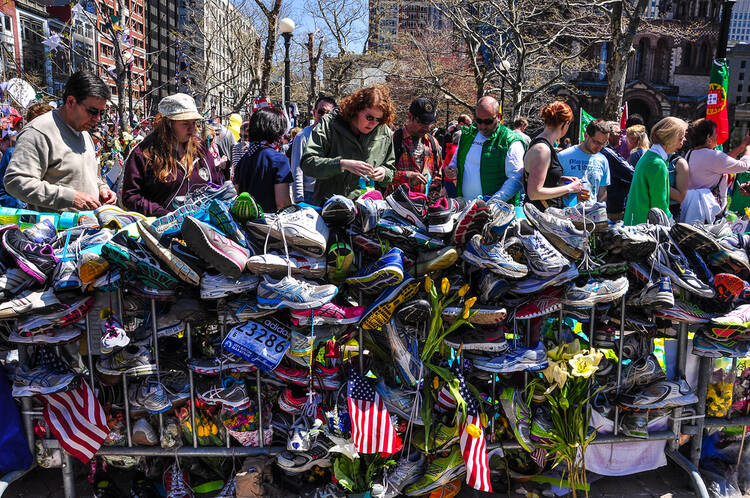A federal prosecutor portrayed Dzhokhar Tsarnaev as a monster who chose the most vicious means imaginable to cause death and injury at the Boston Marathon in 2013. The government began its argument for a death sentence on Tuesday, almost two weeks after Tsarnaev was convicted on 30 counts of murder and terrorism. Nadine Pellegrini, making the prosecution’s opening statement in the penalty phase of the trial, called Tsarnaev “America’s worst nightmare” and made a single passing reference to “jihad.” But she did not attribute any coherent religious or political philosophy to Tsarnaev, instead implying that he chose terrorism for its own sake.
After displaying photos of the three people killed in the bombings and the MIT police officer later murdered by Tsarnaev and his brother as they tried to evade capture, Pellegrini finally turned to the easel directly behind her, which she had left covered for almost all of her half-hour statement. She revealed a photo of Tsarnaev, alone in a prison cell, raising a middle finger to the surveillance camera. “This is Dzhokhar Tsarnaev: unconcerned, unrepentant, and unchanged,” Pellegrini said.
In one sense, the photo undermined the prosecution’s claim that Tsarnaev was a fully formed adult who did not need his older brother to embrace terrorism; then 19 years old, he brings to mind a shaggy-haired, bratty teenager. But the middle finger is also a cross-cultural symbol of nihilism and unleashed anger toward fellow human beings. Tsarnaev is not displaying any recognizable version of piety or religious fervor here, which makes it harder for the defense to argue that the government is playing on anti-Islamic prejudice.
Prosecutors have reason to be cautious here. Judge George A. O’Toole Jr., presiding over the case in Boston’s Federal District Court, reminded jurors at the start of the day that they must not use the defendant’s ethnicity or religious beliefs as factors against him. He also said that a death sentence could not be imposed simply to “support or express sympathy” victims of the bombing, which wounded 264 in addition to killing three. At the same time, he warned jurors not to be “swayed” by the public statements of victims and their families with respect to the proper sentence. This was undoubtedly a reference to the opposition to the death penalty expressed by several survivors, including the parents of Martin Richard, the 8-year-old killed in the bombing, and the sister of Sean Collier, the slain MIT officer. If the death penalty is not imposed, Tsarnaev will serve a life sentence in prison without parole.
The Massachusetts Catholic Bishops have also come out against the death penalty. Their April 6 statement reads, “The Church has taught that the cases in which the execution of the offender is an absolute necessity are ‘rare, if not practically nonexistent.’ The Church’s teaching is further developing in recognition of the inherent dignity of all life as a gift from God.”
Across the street from the courthouse on Tuesday morning, two women handed out fliers from the Massachusetts affiliate of the Catholic peace group Pax Christi, calling the death penalty part of “the dark days of tolerating public displays of cruelty and retribution.” About a half-dozen other protesters stood in front of the building and talked to reporters. One banner read, “Why do we kill people who kill people to show that killing people is wrong?”
By late morning, all of the protestors were gone. By then, the prosecution had finished its opening argument and had begun to present testimony from victims, beginning with Celeste Corcoran, a Marathon spectator who described how she lost both legs in the bombings. Corcoran recalled that after she was knocked to the ground by the blast and saw nothing but smoke and blood, her husband immediately guessed that they were the victims of a terrorist attack, but she remembered thinking, “This doesn’t happen here.” Had the Marathon bombings been followed by similar attacks over the past two years, either coordinated or simply “copycat” crimes, Tsarnaev might be facing steeper odds in avoiding a death sentence.
The prosecution is placing great emphasis on testimony such as Corcoran’s. While Tsarnaev’s raised middle finger was the most striking image in her opening statement, Pellegrini spent much of her time describing the lives of the victims, saying, “You know how they died…. Now you need to know how they lived… They were all beautiful, and now they’re all gone.”
Pellegrini also alluded to the issue of whether Dzhokhar Tsarnaev was under the influence of older brother Tamerlan, who was killed while the pair was trying to escape. “It doesn’t really matter who came first” in becoming “radicalized,” she said. “What matter’s is [Dzhokhar’s] belief in terrorism.” But again and again, she avoided discussing any coherent worldview on the part of Tsarnaev beyond a “belief in terror” and a thirst “personal glory.” She summed up his character with: “He simply is callous and indifferent to human life.”
Tsarnaev did not speak during this first day of the trial’s penalty phase, but he could be seen at the defense table, leaning close whenever he discussed something with one of his lawyers (and shaking hands with one of them as she arrived). Whatever the sentence, he’s not likely to ever have such casual interactions with other human beings again.








